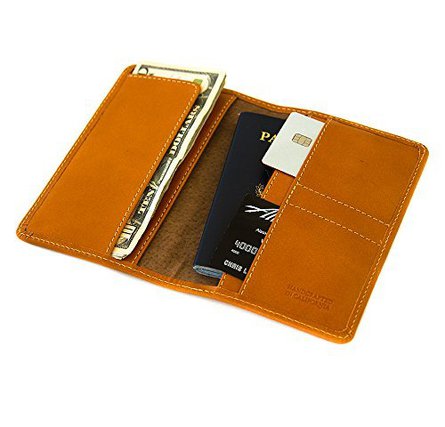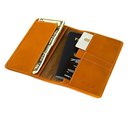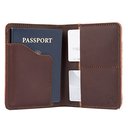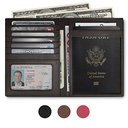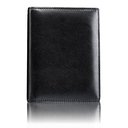What to Consider when Deciding on a Passport Wallet
What factors are important to you? Durability of materials? Price? Capacity and layout? Design and style? We’ll give you some tips on how to find a passport wallet that combines the best features to meet your needs. As a specialty wallet, you shouldn’t settle for anything less than the best. You also shouldn’t have to pay more than the product is worth.
Companies want to sell their products, and they’ll often make their products sound better than they are. We’ll explain what the most common marketing terms and tricks, so you can make an informed decision about what you’re buying. First, we’ll talk about how you can judge the quality of leather and some leather alternatives and then turn our attention to craftsmanship, capacity, features, price, and other factors that might affect your buying decision.
Materials
How long do you want your passport wallet to last? Do you plan to use it for this trip only or do you plan to travel frequently? Purchasing a wallet made of the best materials will make it a lasting investment. Purchasing a passport wallet made of lower-grade materials will cost less but not survive as many trips.
In this section, we’ll show you to examine a wallet or read a product description to evaluate the primary materials. In the next section, we’ll do the same for secondary materials, such as plastic windows. Elastic bands, hinges, clasps, and other added features.
Leather Quality
Did you know that there are different grades of leather? Did you know that genuine leather is a common term for one of the lowest? When you’re reading a product description, note what type of leather the manufacturer says the wallet is made of. It might say full-grain, top-grain, genuine, or bonded. You’ll also see fake leather being advertised under the terms faux leather, koskin, or vegan leather. What are the differences?
Full-grain leather is the least altered. It’s often called the best type of leather by those who like an authentic look. Full-grain leather shows everything from the animal’s hide: its pore pattern, where it was branded, differences in colors, birthmarks, mosquito bites, injuries. Do you want a rustic wallet that reminds you what leather really is? If so, you want full-grain leather. It’s also very durable, lasting 100 years or more.
Would you rather have a passport wallet with an unblemished surface? Top-grain leather is also very durable, lasting just as long, but without showing the history or uniqueness of the animal. Wallet makers craft top-grain leather out of full-grain leather. They do so by sanding the hide down until you can’t see its original markings or feel its original texture. They are then left with a very smooth texture and mostly one color. They can then tan the leather as is or emboss an artificial texture back into the hide. A full-grain passport wallet will show some variations in the texture due to the animal’s unique pore pattern. Top-grain leather with an embossed texture will show a uniform pattern and texture.
The difference between full-grain leather and top-grain leather is style. If you want a more masculine, authentic, rustic wallet, choose full-grain. If you want a more fashionable, uniform, “clean” wallet, choose top-grain. We don’t recommend any other grades of leather, and here’s why.
Genuine leather. Is it leather? It is, barely. Leatherworkers use the top layers of animal’s hide to make full and top-grain leather. They use the bottom layers to make genuine leather. If nothing else was done to the bottom layer, it would be called suede. Does suede sound like a durable material for a wallet? No, suede is used for interior linings or luxury items that you need to be careful with. It’s not a very good material for a wallet. But it is cheaper than full or top-grain leather because there are more bottom layers than top. So, how do wallet makers turn suede into genuine leather?
They coat it with thick layers of polyurethane. They also might emboss it as they would top-grain to give it a leather texture. Adding polyurethane to the bottom layers of a hide does make it more durable but only for a limited amount of time. Polyurethane dries out and cracks. It splits apart. When it does so, the suede leather underneath is exposed and will start wearing down. A wallet made of genuine leather usually doesn’t last more than a couple years.
Bonded leather is even worse. It’s scraps of bottom layers glued (or bonded) back together. Do you want a wallet made of scraps? If you do, get ready to scrap it after a year or so.
Genuine and bonded leather is also sometimes called split leather, referring to the fact that the bottom layers were split from the top. Do you see how manufacturers tell you what the leather is while trying to make it sound better than it is? “Genuine” leather is meant to simply sound like the material is real leather. Bonded sounds like it would be reinforced leather, not leftovers. Split leather doesn’t tell you anything at all unless you know how leather is made.
Koskin, vegan, or faux leather is also coated with polyurethane but isn’t made from animal hide. It can be made from cotton, nylon, or polyester. Polyester and nylon are durable materials. We recommend them both for stitching, and nylon for alternative wallet materials. But coating them in polyurethane carries the same risk as genuine leather or bonded leather. The polyurethane cracks and destroys the appearance of the faux leather.
Do you see the common problem? Trying to make bottom layer leather or other materials look like top layer leather doesn’t work. You’re better off spending more for the full-grain or top-grain leather instead of paying less for low-quality imitations.
What if the product description or packaging doesn’t tell what type of leather the passport wallet is made of? Wallet makers will tell you if they full-grain or top-grain because they’re good materials and companies are proud to use them. Other companies who use vegan, koskin, or faux leather are proud to say that they are making products that are animal-friendly. The only material that no one should be proud of using is genuine or bonded split leather. So, if a company doesn’t tell what type of leather the wallet is made of, it’s probably the lowest grade material. They’re hoping to pass off the product by saying it’s leather and hoping that you don’t know the different types.
Now that you do know the different types of leather, which do you prefer? Authentic full-grain? Fashionable top-grain? Low-cost genuine or bonded? Animal-friendly faux?
Which types of leather do you think will cost more? Any synthetic or low-grade material is going to cost less than top layer leather. You have to harvest top layer leather from animal hides, and there is less material to harvest from the top layers than the bottom. Top layers are also more in demand as a recognized durable material.
All other factors aside and for materials alone, a faux or split leather passport wallet should cost less than $20. A top layer wallet would be fairly priced in the $35 and up (depending on craftsmanship).
Leather Tanning
Here’s another bit of information for you. Did you know that tanning a hide is more than dyeing it? Fathers used to threaten to “tan” their sons’ hides, meaning they would spank them, turning their buttocks red. But tanning a hide is the process of chemically transforming rawhide into leather. There are many different chemicals used in the process, but primary chemicals are either plant-based or chromium tannins.
If a product description says that the wallet is made of vegetable-tanned leather, they’ve used plant-based tannins. Otherwise, they’ve used chromium to make chrome-tanned leather. Vegetable-tanned leather takes longer to make and is, therefore, more expensive. Chrome-tanned leather is the newer method (if 1840 can be called new) and was first utilized when doctors began soaking sutures in chromium to make them last longer after using them sew someone up after surgery.
The third type of tanning is brain tanning. Some one-person crafters might make wallets using brain-tanning, but no industrial wallet makers do anymore. Maybe you’d like to become a wallet maker and help revive the practice?
What you’ll want to be aware of is that vegetable-tanned leather stains when it absorbs water. Chrome-tanned leather also stains but not as much. Water stains will fade as the leather dries but will never go away completely. If you find two wallets that you like and one is chrome-tanned, the other vegetable-tanned, you might want to give yourself a little more protection with a chrome-tanned wallet.
Leather Thickness
More important than tanning methods, however, is the thickness of the leather. How can some leather be thicker than others? Animal hides are very thick. You wouldn’t want a wallet made with the full thickness of a hide. You wouldn’t be able to fold it. Besides the outer layer and interior fold, you have to stack more material onto it to make the pockets. So, wallet makers split the layers, even the top layers from each other, to thin the hide down and use only as much of the material as they want.
That means that a leatherworker can decide how thin to make the material. If they want to make the leather go further, they’ll cut it very thin. If they want to make a more durable wallet, they’ll cut the leather thicker.
What are the negative effects of having thin leather? Thin leather wears through faster than thick and doesn’t retain its shape. It’s too floppy. You could stand it up, and it would sag or fall down because the material is too thin. If it stands upright but still looks thin to you, try pinching the wallet to feel how thick the layers are. You might feel something hard in the lining. It’s not normal. Those are plastic (sometimes cardboard) inserts reinforcing the thin leather.
Is it bad for inserts to reinforce the leather? Our opinion is that if we’re buying a leather passport wallet, we don’t want a lot of non-leather material. The inserts will also rub against the thin leather, causing it to wear through even faster.
If you’re looking up wallets online, you can view our review videos to see Trevor feel each wallet. Sometimes, he even cuts wallets apart to see what’s between the layers.
Most manufacturers who take a shortcut by using thin leather are also those who use genuine or bonded leather. Wallet makers who use top layer leather usually have enough pride in their work that they’ll keep the leather thicker. Because they are using the more durable top layers and reinforcing the durability of the wallet with thicker layers, you should expect to pay more for a thicker passport wallet.
Leather Scent
Do you know what leather smells like? It all smells very similar. You could describe it as earthy or slightly must with a tang to it. What it doesn’t smell like are chemicals. And it’s not fragrance-free. If you’re shopping in person, take a whiff of the wallet. If you’re shopping online, watch Trevor smell the wallets we review.
If you smell chemicals, it’s probably a low-quality wallet coated in polyurethane or other thick finishes. If you don’t smell anything, it’s a low-quality wallet that’s been sitting for a while, long enough to lose the chemical scent. If you’re looking for a high-quality wallet, identify it by smell and know that it will never lose that scent, no matter how long it stays in your hands or in your pocket.
Leather Feel
Last comes the feel test. We won’t ask if you know what leather feels like. Instead, do you know how plastic feels? It doesn’t feel like leather. Depending on whether you’re buying full-grain or top-grain, the leather will feel smooth or textured. It should not feel completely slick. Even a smooth top-grain passport wallet should have some small texture to it from the animal hide. If you find a wallet that just feels like wax or plastic, assume that it’s a type of split leather covering its poor quality with thick finishes.
Leather Quality Summary
Before we move on to other materials, let’s review what we’ve covered so far. What are the best types of leather? Full and top-grain are the best in every sense. They’re durable. They feel and smell like leather. They’re usually cut thicker. And full-grain leather even preserves the authentic, unique character of the hide it came from. Because full and top-grain leathers are the best materials, passport wallets made of them will also cost more than those made from split or faux leather.
Nylon
What is nylon? It’s plastic, isn’t it? And we’re against plastic!
Whereas it’s true that we don’t want a leather wallet that feels like plastic, a true nylon wallet isn’t trying to be a leather wallet. It’s something completely different. It’s also comfortable. Nylon bends and flexes similar to leather. You won’t find many passport wallets made of nylon, but if you do find one that you like, it should be very durable. The reason you won’t find as many is that nylon isn’t as fashionable as leather. It’s more for minimalist or sports wallets because they don’t stain when they get wet. They’re also very affordable, costing about as much as a split leather wallet for better durability. Most nylon wallets appeal to younger or casual men. Keep your eye out for nylon though. If you like the look as well or better than leather, it might be worth the purchase.
Polycarbonate
How would you like to put a hard plastic shell in your pocket?
Polycarbonate is another plastic that finds its way onto our list. It’s not a common material for passport wallets, but they are very secure. People often use polycarbonate wallets for their crush-proof protection. That protection comes at the expense of comfort though. These wallets are made of hard plastic better kept in a bag or suit jacket pocket than in your pants. If you have a carry-on, you might consider keeping your passport, tickets, passes, cards, and bills secure in a polycarbonate passport wallet.
Like nylon, polycarbonate passport wallets should cost a fraction of the price of full-grain or top-grain.
Construction
How long will a high-quality leather, nylon, or polycarbonate passport wallet last? As long as the stitching, hinges, and other components hold it together. Other features, such as money clips, snaps, pull-tabs, ID windows, or zippers can enhance a passport’s functionality or bring down its overall value.
Let’s examine some of the most common necessary and extra materials that go into a wallet.
Stitching
Unless you’re buying a polycarbonate passport wallet, you should see stitching all around the edges of the various layers and pockets. If you don’t see stitches, it’s held together by glue. The clean panels might look neat and stylish, but any type of adhesive will break down and let the panels pull away from each other as the wallet moves and flexes.
Nylon or polyester stitches are the best choices. Cotton is a suitable alternative at a lower cost. Both nylon and polyester hold up well in water and do not fray as easily as cotton. All three thread types, however, should be double-stitched along the edges of pockets and material layers to provide extra strength against stress when the pocket is full. You might also see some passport wallets with a cross or x stitching pattern. It looks very stylish and serves the same purpose of reinforcing the threads. It’s not the right look for all wallets though. You’ll see it mostly in casual-style wallets.
Like leather, if a wallet maker doesn’t tell you what type of thread they used, the stitching is probably the lowest grade. Unlike leather, however, cotton stitching shouldn’t be a deal breaker on the wallet as long as it is double stitched.
What should be a deal breaker is tied off threads or ends that are simply looped through the stitching. That kind of finish to the stitching looks unprofessional, and it won’t last. The ends will come loose, and the entire stitching job will start coming undone. It’s a much better practice to melt the ends of the threads together. When a wallet maker does it right, melted ends look clean and subtle. They also keep everything tight.
Lining
What kind of lining should a passport wallet have? The best materials are pigskin or suede. They’re durable and perfectly suited for interior use. They’re also both types of leather, perfectly completing a leather passport wallet. Nylon and polyester are durable alternatives with silk and cotton being the least. Silk looks and feels nice but rips very easily when a card with a rough edge slides up and down it. Cotton snags and frays.
No matter what type of lining the pockets have, the most important part is the stitching. Look down the interior of the pocket and check that the stitching does not run across the width of the pocket. Also, check that threading does not protrude from the edges. A card should never slide across the stitching. That’s the best way to snag the threads and loosen the stitching. It’s also annoying trying to pull a card out or slide it back in when it gets stuck on a thread.
Clips, Snaps, Hinges, and Hardware
A passport wallet might also come with a money clip, notebook clip, pen clip, or itinerary clip. They might be magnetic or spring clips. They might also have a winding tensioner. You should test the clips’ action in multiple ways. Here are some questions to ask.
How tight is the clips’ action opening and closing the mechanism? When closed, how secure is it? How many bills or how thick of material can it hold without loosening? Does it move side to side or stay centered? How securely is it attached to the interior of the wallet?
Test snaps or hinges the same way, asking questions like, How easy it to open the wallet again? Is it likely to pop open on its own? How much of a gap does the closed wallet leave? Could anything slide out through the gap? Are the snaps securely fastened to the interior of the wallet? Are they likely to pull away or cause rips in the material? Is the hinge of sufficient quality to handle frequent opening and closing? Does it move back and forth?
You should test any other type of hardware sewn or punched into the wallet. Move it around and get a sense of its durability.
Zippers
Passport wallets will commonly feature a zipper that wraps around the entire case. It’s an added security feature for traveling. Use the zipper a few times to see how strong it is. Does it take a little force to zip or is the zipper likely to slide open on its own? Does it zip all the way to the end or does it leave the last couple of teeth open, ready to start pulling the wallet open? Is the zipper fabric double stitched to the wallet’s interior all the way around so that it won’t pull away when you quickly zip and unzip the opening?
Weak zippers give the illusion of security. Strong zippers actually provide it.
Plastic and Elastic
A passport wallet might have a plastic window on either the outside or inside. It also might have an elastic band or pull-tab. Ask yourself if you really need any of those features in a passport wallet because they’re likely to be the first parts to tear.
An interior ID window is better protected than an exterior but is still subject to dents, scratches, and punctures. An elastic band or pull-tab can only be pulled on so many times before it stretches out. Elastic is also subject to ripping, fraying, and snagging on other materials. They’re nice features but might not be worth the cost for their low durability.
We especially wouldn’t buy a passport wallet that relies on an elastic band to keep it closed. And you might consider looking for a passport wallet that has a recessed window with no plastic covering. Your ID in the recessed window will be protected by the surrounding material.
Craftsmanship
Craftsmanship differs from material durability and construction in that it focuses on how well all the pieces have been put together. Did the wallet maker take shortcuts when they were finishing the wallet? Did they exhibit any special skill? You can tell the difference between a well-crafted wallet and one that was made in a hurry by inspecting the evenness of the cuts, the angle of the lines, and how the corners and edges were finished.
Cuts and Lines
Look along the edge of each cut. Does it look even? Are they straight? Or do the cuts appear jagged or wavy? Are the lines of the cuts parallel or perpendicular to the rest of the wallet’s edges and lines?
Pocket Edges
Apart from the evenness and angle of the pocket edges, how are they finished? Does the material stop at the top of the pocket or does it fold over down into the pocket? Does it form a rolled seem in the front?
If the material stops at the top of the pocket, does it feel thick enough to be sturdy? Does it lay flat or pucker out?
If it folds over, how far does it go down? Does it create a lip that cards could snag or get stuck on?
If it rolls down in front, how thick is the pocket below the roll? Did they roll it because the material was thin or did they purposely thin the top to make a decorative finish?
Ideally, the pockets should be finished with thick enough leather and in a manner that doesn’t hinder the use of the pocket. Thick pockets with rolled over edges show high-quality craftsmanship because the wallet maker has to thin the top of the pocket to be able to make that roll while keeping the material below it thick enough for durability. You won’t see rolled pockets with a proper thickness in anything but premium wallets.
Corners
Finally, inspect the edges and corners of the inside fold. Can you see each layer of leather down the edge of the wallet, like the material was stacked to form steps? If so, the wallet maker didn’t finish the edges at all. It makes for a unique, homemade look, but it detracts from the durability of the wallet.
The edges should be thinned so that they blend into one another, creating a smooth surface. The corners should also be thinned and cut into rounded edges so that they don’t crumple or fold over.
You might see a passport with smooth edges and rounded corned covered in a bonding material. That’s a cheap shortcut. It’s like slapping polyurethane on split leather to make it look like finished leather. The bonding material is covering up the unblended edges, but it will also peel away from those edges as it dries and cracks.
A well-crafted passport wallet will have even cuts, straight lines relative to the rest of the wallet, thick cut off pockets, folded pockets that extend the length of the pocket, or thick pockets with thinned tops to roll over, and rounded corners with edges blended all the way down the length of the wallet.
Warranty
How much attention do you pay to a product’s warranty? Like the different terms for the grades of leather, marketers can give you clues as to how durable their products are with the length of the warranties they offer.
We’ve seen companies offer no warranty beyond the required 30-day return policy up to 100 years. So, how long of a warranty do you need, and what are marketers telling you by the length of their product’s warranty? The extremes are actually good signs. If a passport wallet comes with no warranty or an extremely long warranty, the company is either claiming that you won’t need a warranty because their product is that durable or that they’re willing to stand behind a product’s durability for a very long time.
An extremely short warranty, on the other hand, is a bad sign. Some wallet manufacturers give you 3 or 6 months to return a product or ask for repairs. Why so short? It’s because they know that their products won’t last much longer than that. They’re giving you a warranty to reassure you when it should warn you away.
Another warning sign is money-back guarantees with no questions asked. That sounds nice, right? They’re not going to hassle me if I want to return the product. But it’s a sign that they’re standing behind their financial security, not their product. They’re trying to sell enough products that they won’t mind refunding some people’s money. Their products are so cheaply made that it won’t be a significant loss.
A more appropriate warranty covers a couple of years. If you use your passport wallet a few times a year or more, how long will it take you to notice a problem with the materials or craftsmanship? Two or three years gives you ample time to notice a defect. You might have problems from normal wear and tear beyond that, but the manufacturer has proven the quality of their product if you don’t find a problem with it in the first couple of years.
Size and Weight
Since a passport wallet has to hold a passport, it needs to be larger than a standard cash and card wallet. It will also weigh a little more. That’s okay because you’re not going to put your passport wallet sticking out of your back pocket (that’s just asking for someone to pluck it out), and you’re not even going to try stuffing it in your front pocket. This is a suit jacket or shirt pocket wallet only.
To comfortably fit a passport, the measurements will be approximately 4.5 inches wide by 6 inches tall. The weight will vary, but a passport wallet that’s thick enough to be durable should weigh at least 100 grams. Because it goes in your shirt or jacket, don’t worry about the weight causing your clothes to sag.
Capacity
How much should a passport wallet hold? For security reasons, a passport wallet should hold only the essentials for your trip. This probably isn’t going to be your everyday wallet, so you can leave out all your store membership cards and business cards you’ve collected. You can probably leave out a lot more after reading our guide on How to Reduce the Contents of Your Wallet.
What will you need is your passport, tickets, boarding passes, government ID, a bank card, credit card, some cash for tips, and insurance cards along with any other work badges or documentation you might need. If you’re traveling with family members, you might also want to carry all of your passports and travel documents in one passport wallet to keep everything together. There are passport wallets thick enough to accommodate you.
Before you buy, test the pockets to see if they’ll hold everything you need. The arrangement of pockets is especially important. You’ll want to be able to organize everything in secure pockets that are also easy to use. Outside pockets or bands might not be a good idea when you’re traveling, and flap pockets probably won’t hold anything as securely as it should.
Features
How do you want to use your passport wallet? Is it for the airport or traveling only or will you use it when you arrive at your destination? Do you need it to include smaller pockets for SIM cards? Do you need it to have a pen and holder for taking notes? Do you want mesh pockets so you can see what’s in them? Should the wallet include a zipper or snaps for added protection?
Think of the ideal passport wallet and then look for one that includes the features you’re looking for. But think about what you really need too. Adding too many features to a wallet provides more opportunity for one of those features to fail. Simpler passport wallets will be more durable.
RFID Protection
One feature that’s always a good idea, especially when you’re traveling, is RFID protection. Almost everyone carries RFID (radio frequency identification) cards without knowing how they work. The technology is used in credit and bank cards, driver’s licenses, and key access cards as well as some types of membership cards. When you insert your card into a reader, it uses radio frequencies to read your information.
The problem is that can scanners can read the information off of your cards even when you don’t insert them into a reader. They can even read the information while the card is still in your wallet in your pocket. Crazy, right?
Some unscrupulous persons make a living from scanning other people’s information and then making illegal purchases. Tourist shops can scan your card as soon as you enter their shop and charge you whether you buy anything or not. Other nefarious fiends try to scan your key cards, hoping to help themselves to your belonging when you leave your hotel room.
That’s where RFID protection comes in. It’s a metallic mesh insert between the layers of your wallet. It blocks radio scans so that you can’t be taken advantage of. You can purchase a passport wallet that block financial and personal information only (stored at 13.56 MHz) or one that also blocks key card encoding (125 kHz). You might also find passport wallets that feature protection in some pockets, but not others so that you can configure your wallet for your convenience.
If the passport wallet you want doesn’t feature RFID protection, consider purchasing separate RFID sleeves. They slide over your cards, creating their own radio frequency barriers. They will add to the thickness of your cards, though, so you won’t be able to fit as many in each pocket.
Design
Are you a fan of a certain brand? Do you like the style of their logo or company mascot? You might enjoy a large design on your passport wallet. Maybe it features a decorative pattern that appeals to you. Or would you rather have a plain case with a small brand name on the inside?
Whichever you choose, think about whether you will still like the look of the passport wallet 5, 10, or 20 years from now. If you buy a high-quality passport wallet, it should certainly last that long, but your opinion of its design might not. And if you’re not sure you like it now, it won’t look any better as time goes by. As with most highly durable items, the subtler the design, the better to ensure that it doesn’t go out of fashion.
Purchase Options
What’s your favorite color? You can probably find it in a passport wallet. Leather, nylon, and polycarbonate can all be dyed any color. Most passport wallets come in more than one. Most of the color options will be traditional leather shades of black or brown, but there is a lot of variety in brown. If you look hard enough, you can also find brighter colors to match your personality.
Packaging and Gift Boxes
Passport wallets tend to be more expensive than daily wallets, so check to see how yours will be shipped. A careful seller will package the passport wallets in its own box inside a larger shipping box filled with packing material to ensure that it doesn’t get punctured or scratched in transit.
Passport wallets also make great gifts. Some even come in a gift box. But check how the gift box is supposed to look. Some companies “gift box” is just a plain white box or cardboard envelope. It works for wrapping the wallet, but it doesn’t look very nice itself. Other companies’ gift boxes show the value and quality of the gift with a printed design and a sturdy enough box that you wouldn’t need to wrap.
Price
Passport wallets aren’t as common as daily wallets, so they’ll be pricier for that reason alone. They’re also larger, requiring more material, especially if they’re of sufficient thickness to be worth buying. And as we noted, high-quality materials and craftsmanship cost more. With that in mind, it’s not unreasonable for a passport wallet to cost $100 or more.
The relatively high price should be mitigated by the fact that the wallet should last through decades of use. Consider it part of the expense of your trip that you can re-use every time you travel.
But don’t pay more than you have to for branding. Some companies charge you more for their name than the quality of their product. Other companies are smaller or more subtle in their marketing and choose to offer lower prices for the same quality. Our advice is to buy the less expensive option if it passes all of the inspection criteria we listed above. It doesn’t matter if you’ve never heard of the company. Quality speaks for itself.
Conclusion
Which is the best passport wallet for you? The Made in Mayhem, Bellroy, and Saddleback Leather designs are all highly durable with the Saddleback Leather model being the least expensive option. The Made in Mayhem wallet, however, does feature the front cash pocket, and the Bellroy has two more card pockets than either one. When you need a less expensive wallet or a design with more convenient capacity, the Inspiring Adventures and Travel Navigator models become very attractive options.
